This article was co-authored by Diana Lee, MD. Dr. Diana Lee is a Surgical Retina Fellow. She received her MD from Georgetown University in 2015, did her fellowship at UCLA's Jules Stein Eye Institute, and completed her first residency at USC's Roski Eye Institute. Currently, she is a resident at the Los Angeles County Department of Health Services and a clinical fellow with Associates in Ophthalmology. Her research interests are diverse and include: cataract surgery, dry eye, thyroid eye disease, retinoblastoma and diabetic retinopathy.
wikiHow marks an article as reader-approved once it receives enough positive feedback. This article received 16 testimonials and 85% of readers who voted found it helpful, earning it our reader-approved status.
This article has been viewed 292,286 times.
A wrist sprain occurs when ligaments in the wrist become stretched too far and tear (partially or entirely). In contrast, a wrist fracture occurs when one of the bones in the wrist breaks. Sometimes it can be difficult to tell the difference between a wrist sprain and fracture, as both injuries generate similar symptoms and are caused by similar accidents — falls on an outstretched hand or a direct blow to the wrist. Indeed, a fractured wrist very often involves sprained ligaments. To definitively distinguish between the two types of wrist injuries a medical assessment (with x-rays) is required, although it's possible at times to be able to differentiate between a wrist sprain and fracture at home before heading off to a clinic or hospital.[1]
Steps
Diagnosing a Wrist Sprain
-
1Move your wrist and assess it. Wrist sprains have a wide range of severity depending on the degree of stretch or tearing to the ligament(s). A mild wrist sprain (Grade 1), infers some ligament stretching, but no significant tearing; a moderate sprain (Grade 2) infers significant tearing (up to 50% of the fibers) and may be associated with some loss of function; a severe sprain (Grade 3) infers a greater degree of tearing or complete rupture of ligaments. As such, movement in your wrist will be relatively normal (albeit painful) with Grade 1 and 2 sprains. A Grade 3 sprain often leads to instability (too much range of motion) with movement because the ligaments attaching the wrist bones are completely torn.[2]
- In general, only some Grade 2 and all Grade 3 wrist sprains need medical attention. All Grade 1 and most Grade 2 sprains can be managed at home.
- A Grade 3 wrist sprain can involve an avulsion fracture — the ligament tears away from the bone and takes a small chip of bone with it.
- The most common ligament sprained in the wrist is the scapho-lunate ligament, which connects the scaphoid bone to the lunate bone.
-
2Identify the type of pain you are feeling. Again, wrist sprains are highly variable in severity, so the type and/or amount of pain varies greatly also. Grade 1 wrist sprains are mildly painful and the pain is often described as a soreness that can be sharp with movement. Grade 2 sprains are moderately or severely painful, depending on the degree of tearing; the pain is sharper than a Grade 1 tear and sometimes also throbbing because of the increased inflammation. Perhaps paradoxically, Grade 3 sprains are often less painful initially than a Grade 2 sprain because the ligament is completely severed and not irritating surrounding nerves as much. However, Grade 3 wrist sprains eventually start to throb quite a bit due to the accumulating inflammation.[3]
- Grade 3 sprains that involve an avulsion fracture are very painful immediately, and involve both sharp and throbbing type pain.
- Sprains generate the most pain with movement and are usually much less symptomatic with lack of movement (immobilization).
- In general, if your wrist is very painful and difficult to move, see your doctor right away and get it assessed.
Advertisement -
3Ice it and see how it responds. Sprains of all grades respond well to ice or cold therapy because it reduces inflammation and numbs surrounding nerve fibers that generate pain. Ice is particularly important for Grade 2 and 3 wrist sprains because they cause more inflammation to accumulate around the injury site. Applying ice to a sprained wrist for 10–15 minutes every one to two hours immediately following an injury makes a big impact after a day or so and significantly reduces the intensity of pain, which makes movement much easier. In contrast, icing a wrist fracture is certainly helpful for pain and inflammation control, but the symptoms often return after the effects wear off. Thus, as a general rule, cold therapy is more impactful on sprains that it is on most fractures.[4]
- The more serious the sprain, the more swelling you'll see localized around the injury, which will make the area look puffy and enlarged.
- Small hairline (stress) fractures are often more impacted by cold therapy (long term) than more serious fractures, which require medical attention.
-
4Check for bruising the next day. Inflammation creates swelling, but that's not the same as bruising. Instead, bruising is caused by localized bleeding into the tissues from injured small arteries or veins. Grade 1 wrist sprains usually don't cause bruising, unless the injury was from a hard blow that crushed the small subcutaneous blood vessels. Grade 2 sprains involve more swelling, but again, not necessarily much bruising — it depends how the injury occurred. Grade 3 sprains involve lots of swelling and typically significant bruising because trauma that causes ruptured ligaments is usually severe enough to also rip or damage the surrounding blood vessels.[5]
- Swelling from inflammation doesn't cause much color change in the skin, aside from some redness from "flushing" due to the heat created.
- The dark blue color of bruising is caused by blood leaking into the tissues just below the surface of the skin. As the blood degrades and gets flushed out of those tissues, the bruise changes color (lighter blue, then eventually yellowish).
-
5See how it feels after a few days. Essentially all Grade 1 wrist sprains, and some Grade 2 sprains, feel significantly better after a few days, especially if you rest the injury and apply cold therapy to it. As such, if your wrist feels pretty good, there's no visible swelling and you can move it without much pain, then likely no medical intervention is needed. If your wrist was more seriously sprained (Grade 2), but feels significantly better after a few days (even if some swelling is noted and the pain is still moderate), then give it a little more time to recover. However, if your injury hasn't improved much or is actually worse after a few days, then a medical assessment is likely needed as soon as possible.[6]
- Grade 1 and some Grade 2 sprains heal quickly (one to two weeks), whereas Grade 3 sprains (particularly with avulsion fractures) take the most amount of time to heal (sometimes a few months).
- Hairline (stress) fractures can also heal pretty quickly (couple of weeks), whereas more serious fractures can take a few months or more, depending if surgery is done.
Diagnosing a Wrist Fracture
-
1Look for misalignment or crookedness. A wrist fracture can be caused by similar types of accidents and trauma that cause wrist sprains. In general, the larger and stronger bones are, the less likely they are to break in response to trauma — instead, the ligaments will stretch and tear. But when they do, they often create a misaligned or crooked appearance. The eight carpal bones of the wrist are small, so a misaligned or crooked wrist may be difficult (or impossible) to notice, especially with hairline fractures, but more serious breaks are easier to tell.[7]
- The most commonly broken long bone within the wrist area is the radius, which is a forearm bone that attaches to the small carpal bones.
- The most commonly fractured carpal bone is the scaphoid bone, which is unlikely to cause a noticeable wrist deformity.
- When a bone penetrates the skin and becomes visible, this is known as an open or compound fracture.
-
2Identify the type of pain. Pain from a wrist fracture also depends upon severity, but it's usually described as very sharp with movement, and deep and achy without movement. The severe pain of wrist fractures tends to increase during gripping or squeezing of the hand, which is not often the case with wrist sprains. Wrist fractures usually cause more symptoms in the hand, such as stiffness, numbness or inability to move the fingers, in comparison to wrist sprains because there is a greater chance of nerve injury/damage with fractures. Furthermore, there can be a grinding or crunching sound when moving a fractured wrist, which doesn't occur with wrist sprains.[8]
- Pain from a wrist fracture is often (but not always) preceded by a "cracking" sound or feeling. In contrast, only Grade 3 sprains can produce a sound or similar sensations, and that's sometimes a "popping" sound as the ligament ruptures.
- As a general guideline, wrist pain from a fracture will get worse at night, whereas pain from a wrist sprain will plateau and not flare-up in the night if the wrist is immobilized.
-
3Assess if symptoms are worse the following day. As noted above, a day or two of rest and cold therapy can make a big different in a mild-to-moderate wrist sprain, but the same can't be said for fractures. With the possible exception of hairline fractures, most broken bones need significantly more time to heal than ligament sprains. Thus, a couple days of rest and icing doesn't make much impact on the symptoms caused by most fractures, and in some cases, you may feel worse once your body gets over the initial "shock" of the injury. [9]
- If a broken bone in the wrist pokes through the skin, then the risk of infection and significant loss of blood are high. Get medical attention as soon as you can.
- A severely broken bone in the wrist may completely cut off circulation to the hand. The swelling from the blood causes what is called "compartment syndrome," which is considered a medical emergency. When this occurs, the hand will feel cold to touch (from lack of blood) and turn pale (a bluish white).
- A broken bone may also pinch or sever a nearby nerve, which might lead to complete numbness in the region of the hand that the nerve innervates.
- If there is a lack of circulation to the fingers, severe pain or numbness, go to the emergency room immediately.
-
4Get an x-ray from your doctor. Although the above information can guide you to make an educated guess on whether your wrist injury is a sprain or a fracture, only an x-ray, MRI or CT scan can tell for sure in most cases — unless a bone is poking through your skin. An x-ray is the most economical and common way to view the small bones of the wrist. Your doctor will likely refer you for a wrist x-ray and get the results verified by a radiologist before consulting with you. X-rays only visualize bone and not soft tissues such as ligaments or tendons. Fractured bones can be tricky to see on x-ray because of their small size and the confined space, and it can take a few days for them to be visible on x-rays. To visualize the extent of ligament damage, your doctor will refer you for an MRI or CT scan.[10]
- An MRI, which uses magnetic waves to provide detailed images of structures within the body, may be needed to detect a fractured bone in the wrist, particularly broken scaphoid bones.
- Hairline fractures in the wrist are very difficult to see on regular x-rays until all the inflammation fades away. As such, you may have to wait a week or so to confirm the fracture, although by that time, the injury is well on its way to healing.
- Osteoporosis (brittle bones due to lack of mineralization) is a major risk factor for wrist fractures, although the condition doesn't really increase the risk of wrist sprains.
Warning
- If left untreated, a fractured wrist increases the risk of osteoarthritis developing.
References
- ↑ https://health.clevelandclinic.org/childhood-injuries-sprain-vs-fracture/
- ↑ http://orthoinfo.aaos.org/topic.cfm?topic=a00023
- ↑ http://orthoinfo.aaos.org/topic.cfm?topic=a00023
- ↑ https://health.clevelandclinic.org/childhood-injuries-sprain-vs-fracture/
- ↑ https://www.nhs.uk/conditions/sprains-and-strains/
- ↑ https://www.nhs.uk/conditions/sprains-and-strains/
- ↑ https://www.urmc.rochester.edu/encyclopedia/content.aspx?contenttypeid=1&contentid=1889
- ↑ https://www.assh.org/handcare/condition/wrist-fracture
- ↑ https://health.uconn.edu/orthopedics-sports-medicine/conditions-and-treatments/where-does-it-hurt/hand-and-wrist/distal-radius-fracture/
About This Article
To tell the difference between a wrist sprain and a wrist fracture, try applying ice to your wrist, which will reduce the pain if you’ve sprained it. You may also notice light bruising after a day, which usually indicates a light wrist sprain. Alternatively, if you've fractured your wrist, you may feel sharp pain when moving it, and a deep ache when you rest it. Additionally, check to see if your wrist is misaligned or crooked, which will indicate a fracture. If the pain worsens after a day or two, see a doctor right away, since a fracture can have serious health consequences if it's left untreated. For tips from our Medical co-author on how to tell the difference between a grade 1, grade 2, and grade 3 wrist sprain, read on!
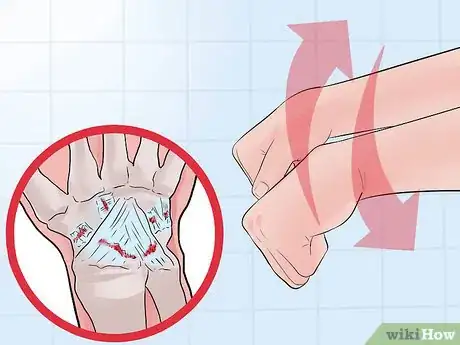


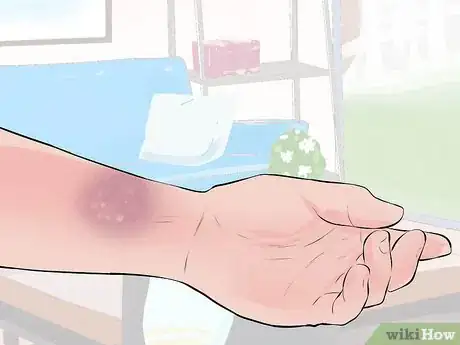
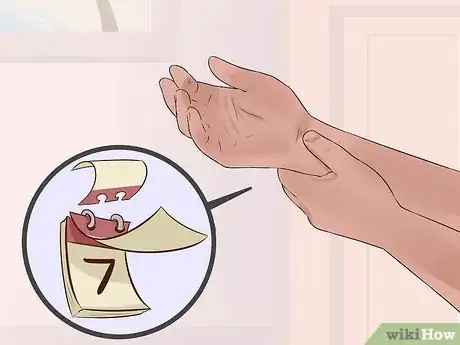
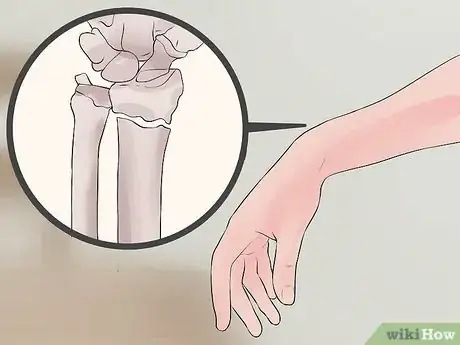
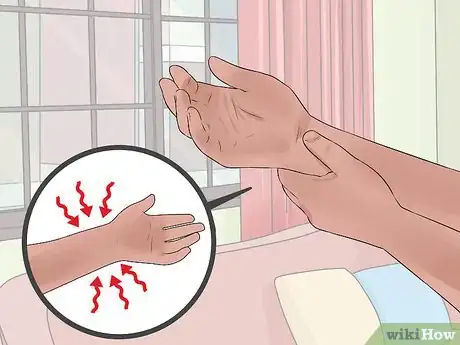
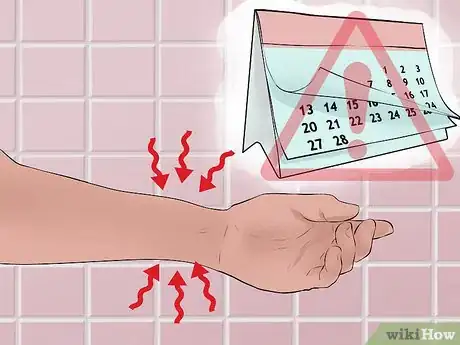
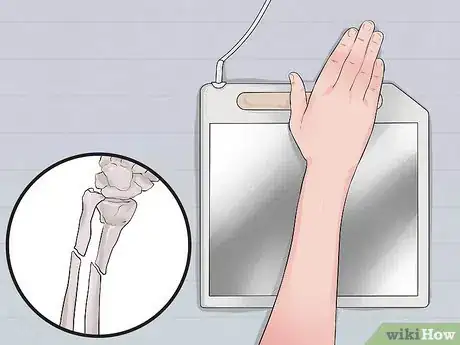




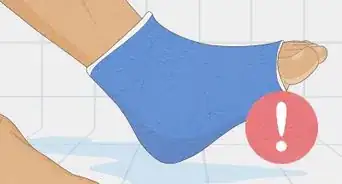

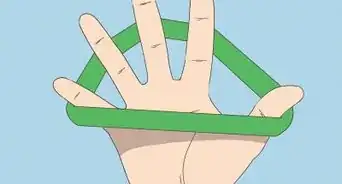

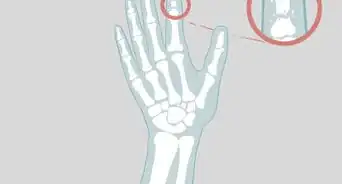























































Medical Disclaimer
The content of this article is not intended to be a substitute for professional medical advice, examination, diagnosis, or treatment. You should always contact your doctor or other qualified healthcare professional before starting, changing, or stopping any kind of health treatment.
Read More...